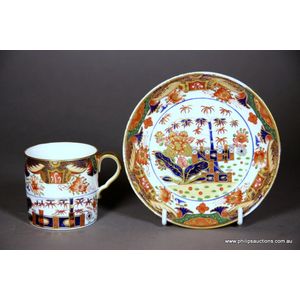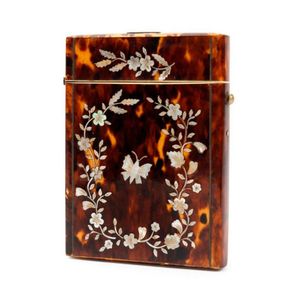Mother of Pearl Inlaid Tortoiseshell Card Case, 19th Century
You must be a subscriber, and be logged in to view price and dealer details.
Subscribe Now to view actual auction price for this item
When you subscribe, you have the option of setting the currency in which to display prices to $Au, $US, $NZ or Stg.
- Mother-Of-Pearl - Mother-of-pearl, technical name "nacre", is the inner layer of a sea shell. The iridescent colours and strength of this material were widely used in the nineteenth century as an inlay in jewellery, furniture, (especially papier mache furniture) and musical instruments.
In the early 1900s it was used to make pearl buttons. Mother-of-pearl is a soft material that is easily cut or engraved.
Nowadays it is a by-product of the oyster, freshwater pearl mussel and abalone industries. - Tortoiseshell - Tortoiseshell is a translucent material that comes from the horny carapace of a certain types of turtles, including the hawksbill turtle. It is often therefore mounted on a colour underground - often red - or inlaid with gold or silver thread, as seen in Boulle furniture.
The texture and colour nuances of the material are extremely important. Heated tortoiseshell can easily be formed into various shapes. Like other natural materials, tortoiseshell becomes more beautiful with use. In a time before plastic, tortoiseshell was widely used for small objects such as combs and powder compacts.
In 1973, the trade of tortoiseshell worldwide was banned under CITES (The Convention on International Trade in Endangered Species). Prior to importing or exporting items containing tortoiseshell a CITES permit must be obtained. Tortoiseshell items cannot be traded on Ebay.
"Faux tortoiseshell", another case of man initiating nature, is made from old-style plastics such as celluloid and cellulos and is coloured with red, yellow and brown spots to imitate the genuine article. It is commonly used in glasses frames, musical instruments and costume jewellery.
This item has been included into following indexes:
-
card cases, English and French
- mother of pearl 103
- tortoiseshell 67
Visually similar items

Vintage 1920's oak sideboard, approx 170 cm high, 183 cm wide

A Chinese Straits porcelain, lozenge shaped dish with yellow enamel panel & blue floral border, the central decoration of long tailed phoenix & dragon, condition: restored chip to rim cm, length 27 cm

A Spode Imari tea cup and saucer, circa 1807, pattern 967 introduced in that year from a Japanese kakiemon design, the straight-sided can and saucer with richly embellished brocaded borders with scrolls, beads and stylised flora, a strikingly modern bamboo

Two silver brooches in the form of an owl, garnet set eyes.
